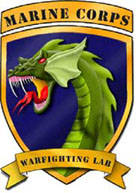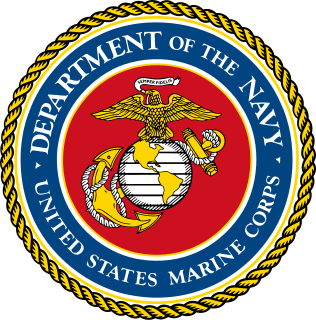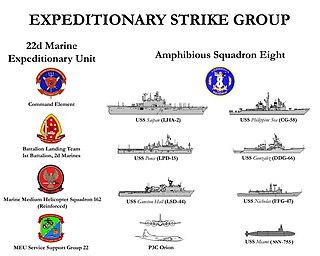Related Research Articles

The Expeditionary Fighting Vehicle (EFV) was an amphibious assault vehicle developed by General Dynamics during the 1990s and 2000s for use by the U.S. Marine Corps. It would have been launched at sea, from an amphibious assault ship beyond the horizon, able to transport a full Marine rifle squad to shore. It would maneuver cross country with an agility and mobility equal to or greater than the M1 Abrams.

The United States Marine Corps Warfighting Laboratory (MCWL) was established in 1995, at Marine Corps Base Quantico, Virginia. The organization was originally known as the Commandant's Warfighting Laboratory. The battle lab is part of the Marine Corps Combat Development Command (MCCDC) and its stated purpose is to improve current and future naval expeditionary warfare capabilities across the spectrum of conflict for current and future operating forces.
Maneuver warfare, or manoeuvre warfare, is a military strategy that advocates attempting to defeat the enemy by incapacitating their decision-making through shock and disruption.
EMW may stand for:
Marine Air-Ground Task Force is a term used by the United States Marine Corps to describe the principal organization for all missions across the range of military operations. MAGTFs are a balanced air-ground, combined arms task organization of Marine Corps forces under a single commander that is structured to accomplish a specific mission. The MAGTF was formalized by the publishing of Marine Corps Order 3120.3 in December 1963 "The Marine Corps in the National Defense, MCDP 1-0". It stated:

The United States Fleet Marine Forces (FMF) are combined general- and special-purpose forces within the United States Department of the Navy that perform offensive amphibious or expeditionary warfare and defensive maritime employment. The Fleet Marine Forces provide the National Command Authority (NCA) with a responsive force that can conduct operations in any spectrum of conflict around the globe.

The United States Marine Corps is organized within the Department of the Navy, which is led by the Secretary of the Navy (SECNAV). The most senior Marine commissioned officer is the Commandant of the Marine Corps, responsible for organizing, recruiting, training, and equipping the Marine Corps so that it is ready for operation under the command of the unified combatant commanders. The Marine Corps is organized into four principal subdivisions: Headquarters Marine Corps, the Operating Forces, the Supporting Establishment, and the Marine Forces Reserve.
In the United States Army, the term combat support refers to units that provide fire support and operational assistance to combat elements. Combat support units provide specialized support functions to combat units in the areas of chemical warfare, engineering, intelligence, security, and communications.

The Navy Expeditionary Combat Command (NECC) serves as the single functional command to centrally manage current and future readiness, resources, manning, training and equipping of the United States Navy's 21,000 expeditionary forces who are currently serving in every theater of operation. The NECC was established in January 2006. NECC is a subordinate command of the Navy's Fleet Forces Command.
The structure of the United States Navy consists of four main bodies: the Office of the Secretary of the Navy, the Office of the Chief of Naval Operations, the operating forces, and the Shore Establishment.
Expeditionary warfare is the deployment of a state's military to fight abroad, especially away from established bases. Expeditionary forces were in part the antecedent of the modern concept of rapid deployment forces. Traditionally, expeditionary forces were essentially self-sustaining with an organic logistics capability and with a full array of supporting arms.

Expeditionary Strike Group 3 is an expeditionary strike group (ESG) of the U.S. Navy. Expeditionary strike groups combine the capabilities of surface action groups, submarines, and maritime patrol aircraft with those of Amphibious Ready Groups for deployment and maintaining staff proficiencies to provide fleet commanders with a highly flexible, ready fly-away unit. It is capable of projecting expeditionary striking power in the maritime, littoral, and inland environs in support of U.S. national interests.

The expeditionary strike group (ESG) is a United States Navy concept introduced in the early 1990s, based on the Naval Expeditionary Task Force. The U.S. Navy fields nine expeditionary strike groups and ten carrier strike groups, in addition to surface action groups. ESGs allow the U.S. to provide highly movable and self-sustaining naval forces for missions in various parts of the world.

The United States Marine Corps (USMC), also referred to as the United States Marines, is a branch of the United States Armed Forces responsible for conducting expeditionary and amphibious operations with the United States Navy as well as the Army and Air Force. The U.S. Marine Corps is one of the eight uniformed services of the United States.
The United States Marine Corps's Advanced Base Force was a coastal and naval base defense force that was designed to set up mobile and fixed bases in the event of major landing operations within, and beyond, the territorial United States. Established in the beginning of the 20th century, the Advanced Base Force was the United States' first combined task force built on the concept of the Marine Corps' traditional role in expeditionary warfare. The slow development of the advanced base force played a significant role in the controversy over the removal of the ships' guards in 1908–1909.

The United States Navy (USN) is the naval warfare service branch of the United States Armed Forces and one of the eight uniformed services of the United States. It is the largest and most capable navy in the world and it has been estimated that in terms of tonnage of its active battle fleet alone, it is larger than the next 13 navies combined, which includes 11 U.S. allies or partner nations. It has the highest combined battle fleet tonnage and the world's largest aircraft carrier fleet, with eleven in service, two new carriers under construction, and five other carriers planned. With 336,978 personnel on active duty and 101,583 in the Ready Reserve, the U.S. Navy is the third largest of the U.S. military service branches in terms of personnel. It has 290 deployable combat vessels and more than 3,700 operational aircraft as of June 2019, making it the third-largest air force in the world, after the United States Air Force and the United States Army.
Special operations capable (SOC) is a collaborated concept formulated of the United States Marine Corps and Navy, under the direction of the Department of the Navy, concerning the expeditionary roles whom the Fleet Marine Force and its subordinate Marine task forces are assigned. This designation is restricted only to the Marine Expeditionary Units—as per "Marine Expeditionary Unit (Special Operations Capable", or "MEU ", and is unique to the Marine Corps and is not associated with the common special operations undertaken by the special operational forces that follow under the United States Special Operations Command —or by any other military branches of the United States—and its primarily and strictly limited to the United States Marine Corps and Navy.
The United States Marine Corps is assigned by the National Command Authority to be primarily the Department of Defense's expeditionary force-in-readiness, and the Department of the Navy's contingent landing force—amphibious by nature. Before 2006, the Marine Corps was the only branch of the Armed Forces that did not have any of its special warfare elements participating in the United States Special Operations Command (USSOCOM), due to confining its special operations capabilities only for the purpose to the Fleet Marine Force.
The United States has a long history in amphibious warfare from the landings in the Bahamas during the American Revolutionary War, to some of the more massive examples of World War II in the European Theater of Operation on Normandy, in Africa and in Italy, and the constant island warfare of the Pacific Theater of Operations. Throughout much of its history, the United States prepared its troops in both the United States Marines and the United States Army to fight land from sea into the center of battle.
References
| This United States Marine Corps article is a stub. You can help Wikipedia by expanding it. |